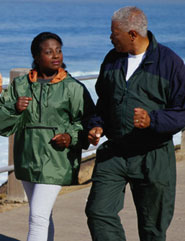How much exercise do you need?
The good news about regular physical activity is that everyone can benefit from it. Additionally, physical activity does not need to be hard or challenging. Participating in moderate-intensity physical activity is an important part of a healthy lifestyle for people of all ages and wide range of abilities.1
Current physical activity recommendations for adults include both cardio or aerobic activities and resistance, strength-building, and weight-bearing activities.

| Recommendations for Adults |
|---|
|
What types of aerobic activities are considered moderate-intensity?
During moderate-intensity activities you should notice an increase in your heart rate, but you should still be able to talk comfortably. If you are breathing hard and fast and your heart rate is increased substantially, you are probably doing vigorous-intensity activity. Many activities (such as bicycling or swimming) can be either moderate- or vigorous-intensity depending on your level of effort. See the measuring intensity section for more information. More examples of moderate-intensity activity are provided below.
| Indoors | Outdoors | Indoors or Outdoors |
|---|---|---|
|
• Dancing, general (Greek, Hula, Flamenco,
Middle Eastern and Swing) • Riding a stationary bike • Actively playing with children • Taking Jazzercise • Scrubbing the floor |
• Mowing lawn, general • Frisbee playing, general • Playing golf, walking the course • Shoveling light snow • Downhill skiing with light effort • Raking leaves |
• Playing basketball, shooting hoops • Walking, brisk pace (mall/around a track/treadmill) • Doing water aerobics • Jogging/walking combination (In a 30-minute period, you should be jogging for less than 10 minutes.) |
For more examples of activities that are considered "moderate-intensity" and "vigorous-intensity," check out General Physical Activities Defined By Level of Intensity (PDF)

What are ways to get the amount of physical activity that I need?
You can reach your goal of at least 30 minutes of moderate-intensity physical activity most days of the week in more than one way: you can do one type of activity for at least 30 minutes, or you can break down your minimum of 30 minutes of physical activity into smaller, 10- to 15-minute segments.3
Think of it as the 3-2-1 plan!
3 – Complete three activities for 10 consecutive minutes at a moderately intense rate
OR
2 – Complete two activities for 15 consecutive minutes at a moderately intense rate
OR
1 – Complete one activity for 30 consecutive minutes at a moderately intense rate
Follow the 3-2-1 and stick with it!
What types of aerobic activities are considered vigorous-intensity?
Most people can get greater health benefits by increasing the intensity or the amount of time that they are physically active. Incorporating up to 60 minutes of moderate- to vigorous-intensity physical activity may also help you manage your weight or help you prevent weight gain, whatever your goal may be.
- Racewalking, jogging or running
- Swimming laps
- Mowing lawn, hand mower
- Tennis, singles
- Bicycling more than 10 mph, or on steep uphill terrain
- Moving or pushing furniture
- Circuit training – a combination of strength, endurance and aerobic exercises
Experts advise that people with chronic diseases, such as a heart condition, arthritis, diabetes, or high blood pressure, should talk to their doctor about what types and amounts of physical activity are appropriate. For more, see When is a medical evaluation necessary?
